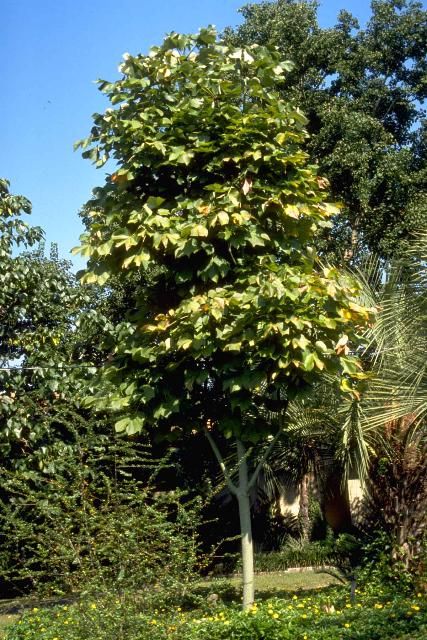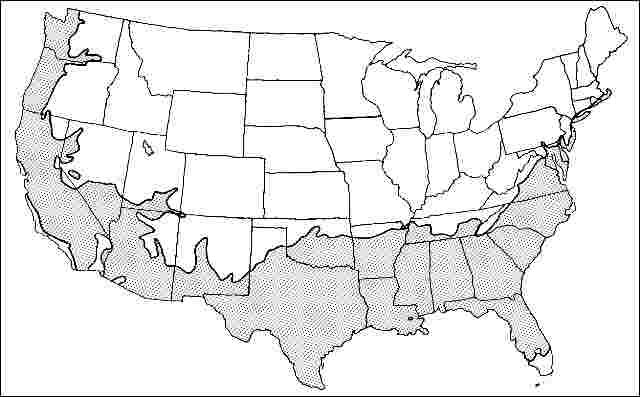Introduction
Chinese Parasoltree has a very unusual appearance for a deciduous tree, having green stems and bark and extremely large, three to five-lobed bright green leaves. Most people either love it or hate it due to its striking habit and coarse texture. Each leaf is up to 12 inches across and casts as much shade as an actual parasol. Chinese Parasoltree has a dense, upright, oval canopy and reaches 35 to 50 feet in height, spreading 15 to 20 feet. In June or July, 10 to 20-inch-long, upright, loose, terminal panicles of yellow/green blooms appear and are followed by the production of peculiar pods which split open into four petal-like sections to reveal the small, round seeds. These pods are often harvested for use in winter decorations. The foliage of Chinese Parasoltree can turn brilliant yellow before dropping in fall to reveal an interesting branching structure of green stems. The yellow complements the green trunk very nicely.

Credit: Ed Gilman
General Information
Scientific name: Firmiana simplex
Pronunciation: fer-mee-AY-nuh SIM-plecks
Common name(s): Chinese Parasoltree, Japanese Varnish-Tree
Family: Sterculiaceae
USDA hardiness zones: 7A through 9B (Fig. 2)
Origin: not native to North America
Invasive potential: invasive non-native
Uses: specimen; highway median; shade
Availability: somewhat available, may have to go out of the region to find the tree

Description
Height: 30 to 50 feet
Spread: 15 to 30 feet
Crown uniformity: irregular
Crown shape: upright/erect, oval
Crown density: moderate
Growth rate: fast
Texture: coarse
Foliage
Leaf arrangement: alternate (Fig. 3)
Leaf type: simple
Leaf margin: lobed, undulate
Leaf shape: star-shaped
Leaf venation: palmate
Leaf type and persistence: deciduous
Leaf blade length: 4 to 8 inches, 8 to 12 inches
Leaf color: green
Fall color: yellow
Fall characteristic: showy

Flower
Flower color: yellow, white/cream/gray
Flower characteristics: showy
Fruit
Fruit shape: elongated, oval
Fruit length: less than .5 inch
Fruit covering: dry or hard
Fruit color: green, tan
Fruit characteristics: does not attract wildlife; showy; fruit/leaves a litter problem
Trunk and Branches
Trunk/bark/branches: branches don't droop; showy; typically one trunk; thorns
Pruning requirement: needed for strong structure
Breakage: susceptible to breakage
Current year twig color: gray, green
Current year twig thickness: thick
Wood specific gravity: unknown
Culture
Light requirement: full sun, partial sun or partial shade
Soil tolerances: clay; sand; loam; acidic; alkaline; well-drained
Drought tolerance: high
Aerosol salt tolerance: unknown
Other
Roots: can form large surface roots
Winter interest: yes
Outstanding tree: yes
Ozone sensitivity: unknown
Verticillium wilt susceptibility: unknown
Pest resistance: free of serious pests and diseases
Use and Management
The tree appears "out of place" to some horticulturists but many people enjoy the dramatic impact one or several of these trees can have on a landscape. The tree lends a tropical effect and is probably best used only occasionally as a specimen. It could be tried as a street tree on a small scale but may be objectionable due to the so-called messy nature of the tree. Leaves are large, decompose slowly and blow around in the landscape after they fall. Falling fruits also contribute to the mess but they are dry. The tree looks a bit scraggly in winter with old flower stalks persisting on the branch tips. There is a tree in Raleigh, North Carolina which is 45 feet tall with an 18-inch-diameter trunk and still growing. But on many sites, count on about 30-years of service unless located in an area with lots of soil space and pruned regularly to develop good form.
Branches can be poorly attached to the trunk so be sure that branches grow no larger than about half the diameter of the trunk. This will help ensure a stronger attachment to the tree. Roots often grow close to the surface in clay soil especially near the trunk.
Chinese Parasoltree should be grown a full-sun, wind-protected location. Trees will grow in shade with an upright, almost columnar form as they reach for the sunlight. Trees should be regularly watered when young but become drought-tolerant once established. They tolerate clay soil but often develop root rot if the soil is not well-drained. Not a downtown tree.
The cultivar `Variegata' has green and white-dappled leaves. Rare in the nursery trade.
Propagation is by seed.
Pests and Diseases
A trunk scale may kill a tree if not controlled.